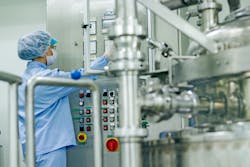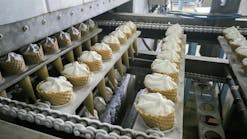About 10,000 pharmaceuticals with about 3,000 active ingredients are approved and marketed in the U.S. These and their reaction byproducts, reactants and solvents can be present in waste streams that require treatment prior to direct or indirect discharges. Pharmaceutical production is a major portion of the chemicals manufacturing industry — in value and product diversity, if not in gross tonnage. Because pharmaceutical chemicals are designed to be biologically active, it is not surprising that disposal of their production waste products into the environment receives particular regulatory scrutiny in many countries. That could be one of the reasons why many pharmaceuticals are now manufactured outside the U.S., usually in Asia under less stringent regulatory conditions; fewer regulatory controls contribute to lower production costs as well as additional contamination.
In the U.S., waste disposal requirements for manufacturing broadly cover chemicals, pharmaceuticals and medicines manufacturing; biological and medical products; botanical drugs and herbs; isolating medical principles from botanical drugs and herbs; and manufacturing pharmaceutical products for internal and external consumption as tablets, capsules, ointments, powders and solutions. These include hazardous wastes, National Emissions Standards for Hazardous Air Pollutants, organic and inorganic chemical manufacturing and Pretreatment and Effluent Guidelines for sewage and water releases covered by the Clean Water Act.
Pretreatment requirements
The national pretreatment program is part of the National Pollution Discharge Elimination System (NPDES) and is a cooperative effort of federal, state and local environmental regulatory agencies to protect water quality. It is delegated to state, tribal and territorial governments. They perform permitting, administrative and enforcement tasks for discharges to surface waters (NPDES program). Pretreatment requirements are intended to protect publicly owned treatment works (POTWs) and other sewage treatment systems and to reduce conventional and toxic pollutant levels discharged by industries and other nondomestic wastewater sources into municipal sewer systems and the environment.
The program requires nondomestic dischargers to comply with pretreatment standards to prevent the introduction of pollutants into a POTW that will interfere with its operation, prevent the introduction of pollutants into a POTW that will pass through into waters of the U.S., causing a violation of an NPDES permit or otherwise be incompatible with it, and improve opportunities to recycle and reclaim municipal and industrial wastewater and sludge.
There are specific discharge standards and requirements that apply to sources of nondomestic wastewater discharged to a POTW. Reducing or eliminating waste at the source results in fewer toxic pollutants discharged to and treated by the POTWs and perhaps escaping into receiving waters. Pretreatment standards include general and specific prohibitions, categorical pretreatment standards and local limits.
The Effluent Guidelines are broad and complex sets of requirements that pervade many aspects of pharmaceutical production and processing.
Pharmaceutical manufacturing Effluent Guidelines
The cited U.S. Environmental Protection Agency (EPA) 1998 Development Document describes: Best Practicable Control Technology Currently Available (BPT), Best Conventional Pollutant Control Technology (BCT) and Best Available Technology Economically Achievable (BAT) for categories and subcategories of waste products. Standard treatment technologies of all types are used and tailored to the chemical and physical properties of the waste components that are regulated. In addition, there are concerns expressed by some for particular management of chemicals and conditions that can generate antibiotic-resistant microorganisms.
Effluent guidelines are detailed specifications and regulations that apply to facilities in five subcategories: fermentation products, extraction products, chemical synthesis products, mixing/compounding and formulation, and research. Pharmaceuticals are addressed in 40 CFR Part 439. Examples of major components of Effluent Guidelines include the following by section:
439.12 Effluent limitations attainable by the application of the best practicable control technology currently available (BPT) — Any existing point source subject to this subpart must achieve the following
extracted effluent limitations representing the application of BPT:
a. Maximum monthly average limitation for biochemical oxygen demand (BOD) must reflect no less than 90 percent reduction in the long-term average daily BOD5 load of the raw (untreated) process wastewater, multiplied by a variability factor of 3.0.
1. The long-term average daily BOD5 load of the raw process wastewater … is defined as the average daily BOD load during any calendar month, over 12 consecutive months within the most recent 36 months, and must include one or more periods during which production was at a maximum.
2. Calculation of the long-term average daily BOD5 load in the influent to the wastewater treatment system must exclude any portion of the load associated with separable mycelia and solvents, except for residual amounts of mycelia and solvents remaining after the practices of recovery and/or separate disposal or reuse…
3. The practices of recovery and/or separate disposal or reuse include: physical separation and removal of separable mycelia; recovery of solvents from waste streams; incineration of concentrated solvent waste streams (including tar still bottoms); and concentration of broth for disposal other than to the treatment system. … The effluent limitation for BOD5 may be achieved by any of several, or a combination, of these practices.
b. The maximum monthly average limitation for total suspended solids (TSS) … must be calculated as 1.7 times the BOD5 limitation determined in paragraph (a) of this section.
c. Except as provided in paragraph (d) of this section, the limitations for COD are 1675 parts per million (ppm) maximum daily load and 856 ppm maximum monthly average…
439.14 Effluent limitations attainable by the application of best available technology economically achievable (BAT) — This section lists numerical limitations as maximum daily and maximum monthly averages in mg/L for numerous basic process chemicals.
439.15 New source performance standards (NSPS) — These are performance standards for maximum daily and maximum monthly averages for numerous chemicals in mg/L.
The remainder of the regulation describes control requirements for the other categories of contaminants and processes.
Self-assessment tool
The Effluent Guidelines are broad and complex sets of requirements that pervade many aspects of pharmaceutical production and processing. The EPA has produced a Process-Based Self-Assessment Tool for the Organic Chemical Industry (U.S. EPA, 1997) with the aim of providing some level of rationality to assist industry managers and decision-makers. It is intended to help industrial facilities implement a comprehensive environmental management system (EMS) plan tailored to the specific processes and facility so they can plan and operate in the most efficient mode to cope with compliance demands for the myriad requirements. These include self-assessments as part of the EMS to identify integrated and potentially more cost-effective means of achieving compliance. This version is from 1997, so there might be some later revisions available, but they should be fundamentally consistent.
The assessment tool consists of three modules and eight appendices.
Module 1, Process-Based Self-Assessment Approach — It addresses self-assessments and facility
management systems. The general assessment protocol identifies steps toward completing a process-based self-assessment, which includes defining the objectives and scope, identifying the assessment team, compiling and evaluating information and preparing the plan or strategy. Worksheets and templates are provided.
Module 2, Assessment Tool for Production Unit Processes — This identifies common unit processes performed at organic chemical manufacturing facilities and lists possible releases and their related regulations. These include materials handling, reactions, heat transfer and separation. The materials handling segment covers pipes, pumps and storage tanks while the reactions section describes various reactors, heat exchangers, condensers and evaporators with separation techniques such as distillation, ion exchange, filtration, drying, crystallization, centrifugation and extraction.
Module 3, Assessment Tool for Waste Treatment Operations — This module describes waste treatment operations for air, water and solid waste and identifies potential releases and associated regulatory concerns. Baghouses, wet scrubbers, thermal incinerators, flares, adsorption, boilers, cyclones and electrostatic precipitators are discussed for air emissions. Primary, secondary and tertiary wastewater treatment processes are summarized for water. Landfills, sludge incineration, halogen acid furnaces and surface impoundments are described for solid waste.
The appendices include information on relevant aspects of the Clean Air Act, Safe Drinking Water Act, Federal Insecticides, Fungicide, and Rodenticide Act, Emergency Planning and Community Right to Know, Clean Water Act and Toxic Substances Control Act. In addition, there is an extensive section on references and resources relating to process operations, waste treatment, pollution prevention, regulations and inspections.
Conclusion
Pharmaceutical manufacturing and many other industrial segments are covered by the many Pretreatment Requirements and Effluent Guidelines developed by the industrial category. They address an important need to control harmful discharges, and they represent a major technical and operating challenge — to be aware of all regulations and to assure they are met in an economically reasonable manner so NPDES permits will not be violated.
Resources
- Title 40: Protection of Environment PART 439 — Pharmaceutical Manufacturing Point Source Category. https://www.ecfr.gov/cgi-bin/text-idx?SID=890993c0387972f059839fb345376e90&mc=true&node=pt40.32.439&rgn=div5.
- Pretreatment Standards and Requirements. https://www.epa.gov/npdes/pretreatment-standards-and-requirements.
- U.S. EPA (1997). Process-Based Self-Assessment Tool for the Organic Chemical Industry. EPA-305-B-97-002. https://archive.epa.gov/sectors/web/pdf/organic.pdf.
- U.S. EPA (1998). Development Document for Final Effluent Limitations Guidelines and Standards for the Pharmaceutical Manufacturing Point Source Category. EPA 821-R-98-005. July. https://www.epa.gov/sites/production/files/2015-11/documents/pharmaceutical-manufacturing_dd_1998.pdf.



